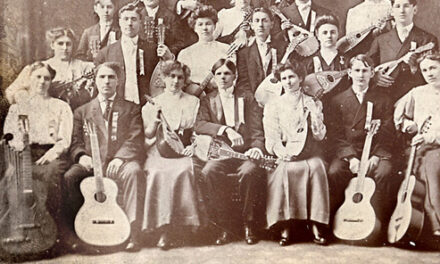Thanks to Bruce Hammond for the wonderful Guest Blog on Grace Ravlin, Fine Artist and Bohmann Harp Guitar Player. And now back to our regularly scheduled program. Here is the last of my collected historical images of historical female harp guitar players – from Italy, then on to Russia!
We begin in a land that I love (Italy) and this stunning and priceless new photograph that I literally just discovered this week while doing a couple of quick checks.

(attribution: M.nottoli, CC BY-SA 3.0 <https://creativecommons.org/licenses/by-sa/3.0>, via Wikimedia Commons)
This is Carmen Lenzi Mozzani, the granddaughter of Maestro Luigi Mozzani, who taught her himself beginning when she was eleven. While she’s well known to Italian guitar historians, I’ve only ever seen her with 6-string guitars (there is one super tiny image in the Mozzani book). The book mentions her playing the “chitarra mezza-lyra” just briefly, but includes intriguing diary notes from Carmen describing the sound of her grandfather’s harp guitar and a couple others – perhaps this one. I can easily picture Grandpa Luigi walking in one lesson day, saying, “OK, granddaughter, it’s time you graduated to the subs.”!
Carmen was born in Renazzo in 1923 and died in 1969. After her grandfather’s death in 1943, the business moved to Rovereto, where she worked as secretary while teaching guitar. She would later concertize on radio and in public, while increasing her activities in guitar publishing and various societies. Perhaps most importantly, like our last featured harp guitarist, she loved to write and left an archive of papers and documents in the Historical Archives at Cento. In one of her memories she wrote about how angry Mozzani would get during her lessons, and describer her guitars: “I began with a rather small guitar, with a knee rest… (that had) …steel, then cat-gut, and then silk strings. Then I passed to a medium sized half-lyra, the soundboard of which I marked with tears; and this, I believe, was later sold to Palladino. Then I had a terzina-guitar, a ‘mezza-lyra diapason 62’, that was my ‘Friend’.”
(Note: the “half-lyre [harp] guitar” she holds in the photo looks full-size, rather than medium size to me. Thoughts? Her favorite one-armed terz harp guitar with 620mm scale would appear even smaller.)

Mozzani had two other female guitar students, who also went on to acclaim. His first was Maria Rita Brondi (above), who again, mainly seems to have played 6-string classical guitar. Yet the book lists her among those who personally owned a Mozzani chitarra lyra – so, like Carmen, she undoubtedly was tasked to give it a go as part of her studies with the 9-string-loving Mozzani.

Photo credits: Intelisano, Cavina and (right) www.chitarrainitalia.it
Sara Stegani was the second young woman to study with Mozzani. Her birth is given as 1911 or 1913. Her career peaked just before WW2, which then forced her to abandon her concert activities. In 1949, she performed at a public commemoration of Mozzani and had just been named director of a new guitar school in Bologna. Tragically, only in her late thirties, she passed away the following year from an incurable disease. The Dizionario dei Chitarristi e Liutai Italiani stated that she owned two Mozzani chitarra mezza-lyras; I don’t know if they were identical or substantially different. Here, she is holding one of the later and relatively modern-looking hollow arm styles built in Mozzani’s Bologna school-workshop. Three additional floating basses were standard for Mozzani’s instruments and his musical needs, as it was for his pupils. Stegani revered Mozzani and continued to play his iconic 9-string instrument. I believe it is important to remember that these Italians from Cento and Bologna were serious classical virtuosos playing their outlandish-looking harp guitars – with their expanded bass range – well into the 1930s and ‘40s.

In early 2000, modern classical guitarist and musicologist Simona Boni acquired one of Ms. Stegani’s original Mozzanis, which she plays often as her standard guitar. In 2005 she recorded the world premiere of Mozzani’s “opere per chitarra” on CD using this instrument. (It need be said that for this music no basses were utilized.)

This picturesque couple, snapped in 1926, is undoubtedly from Genoa or the surrounding Ligurian hills; the harp guitar is a style common to Genoa (and I should know – I searched for harp guitars there four different times). OK, so you noticed she didn’t string her 3 basses – but would you deny me posting this incredible photo? Her partner is playing a Lombardi 6-string mandolin.

www.delcampe.net
This postcard of Filippo Faccenda and his group Compagnia Bella Italia a de Naples includes assorted Neapolitan mandolins with a harp guitar that looks Central European.

From Italy to Southeast Europe: This eBay photograph allegedly hails from Bulgaria.

Certain images just haunt me. I would have pegged this young player and her instrument as Central European if not for noticing the seven strings on the neck, denoting the Russian version of Europe’s harp guitar.

Similarly, while very difficult to make out, this jubilant woman plays a 7-on-the-neck Russian instrument.

But Russian guitarists might play 6-string guitars as commonly as 7-strings, so sometimes it’s very hard to tell! Here, the Russian balakaikas gives the woman away. But does her harp guitar have 6 or 7 strings on the neck? Hard to tell if that’s an additional seventh tuner by the nut…

Can I count “women harp guitar guitarists” if they’re fictional? Don’t know, don’t care. In any event, the young woman beautifully painted by Josef Rainer (1864–) above is undoubtedly a real person posing with a natural playing position and a real instrument (Viennese?).

OK, this one is a fiction. Adolf Hering (1863-1932) famously painted highly stylized women like this one (likely a model) – here with a similarly stylized generic harp guitar (the canary is real). “Duett” – pretty charming!
Next: We wrap up with the women who play the harp guitar today!
Sources
Giovanni Intelisano with Lorenzo Frignani, Luigi Mozzani: Life and Works (Minerva Edizioni, 2008)





